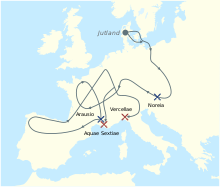
Back معركة أكوي سكستيا Arabic Sekstin Akvası döyüşü Azerbaijani Batalla d'Aigües Sèxties Catalan Bitva u Aquae Sextiae Czech Schlacht von Aquae Sextiae German Batalla de Aquae Sextiae Spanish Aquae Sextiaen taistelu Finnish Bataille d'Aix French Aquae Sextiae-i csata Hungarian Pertempuran Aquae Sextiae ID
| Battle of Aquae Sextiae | |||||||
|---|---|---|---|---|---|---|---|
| Part of the Cimbrian War and Roman–Germanic Wars | |||||||
 John Harris Valda: The Battle of Aquae Sextiae in 102 BC | |||||||
| |||||||
| Belligerents | |||||||
| Roman Republic |
Teutons Ambrones | ||||||
| Commanders and leaders | |||||||
| Gaius Marius |
Teutobod | ||||||
| Strength | |||||||
|
The Battle against the Ambrones The Battle of Aquae Sextiae c. 32,000–40,000 (six legions + auxiliaries) |
The Battle against the Ambrones The Battle of Aquae Sextiae c. 100,000–200,000 (the warriors of the entire tribal coalition)[a] | ||||||
Location within France | |||||||

 Roman victories
Roman victories Cimbrian and Teutone victories
Cimbrian and Teutone victoriesThe Battle of Aquae Sextiae (Aix-en-Provence) took place in 102 BC. After a string of Roman defeats (see: the Battle of Noreia, the Battle of Burdigala, and the Battle of Arausio[1][2]), the Romans under Gaius Marius finally defeated the Teutones and Ambrones as they attempted to advance through the Alps into Italy.[3][4] Some of the surviving captives are reported to have been among the rebelling gladiators in the Third Servile War.[5] Local lore associates the name of the mountain, Mont St. Victoire, with the Roman victory at the battle of Aquae Sextiae, but Frédéric Mistral and other scholars have debunked this theory.[6]
Cite error: There are <ref group=lower-alpha> tags or {{efn}} templates on this page, but the references will not show without a {{reflist|group=lower-alpha}} template or {{notelist}} template (see the help page).
- ^ Duncan 2017, p. 121.
- ^ Duncan 2017, p. 126.
- ^ Duncan 2017, pp. 140–41.
- ^ Livy 2003, 68.3.
- ^ Strauss, Barry (2009). The Spartacus War. Simon and Schuster. pp. 21–22. ISBN 978-1-4165-3205-7.
- ^ Clerc, Michel (1905). " La Légende de Marius en Provence " Annales des Facultés de droit et des lettres d'Aix (in French). Harvard University. Paris : Fontemoing. pp. 273–280.

